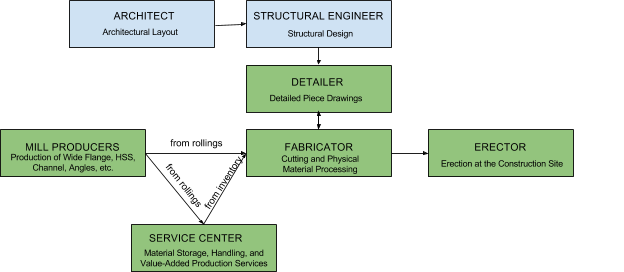Why Steel
Steel Supply Chain
Understanding the structural steel supply chain to increase project value
The domestic structural steel supply chain functions efficiently to quickly transform construction documents into high-precision fabricated and erected structures. An optimized supply chain creates value to the project owner through reduced costs, accelerated schedules and enhanced quality. The American structural steel industry:
Producers
Producers manufacture steel, including hot-rolled structural shapes (wide-flange beams, plate, channels and angles) and HSS (hollow structural sections). Three major structural steel shape producers account for over 90% of all wide-flange shapes produced in the U.S. in five locations. (A couple of quick facts: It takes 0.6 man-hours to produce a ton of structural steel. And thanks to an ongoing nationwide industry that collects and recycles steel scrap in order to make new steel products, domestically produced hot-rolled sections contain an average of over 95% recycled content.)
Service Centers
Service centers function as steel warehouses and provide limited preprocessing of structural material prior to fabrication.They typically carry two to three months of inventory; 65% to 70% of all steel erected in a building or bridge project come from service centers. With such a large amount of material accessible with just a day's notice, structural steel is readily available.
Detailers
Detailers create detail drawings of each piece of structural steel to be used in a project; these drawings are developed from a structural engineer's drawings or a 3D model of the structural frame. These details develop a dimensionally accurate drawing of each piece to be fabricated, including all connection details. The detailing process usually falls under the fabricator's contract and is either performed in-house or subcontracted to an independent detailer.
Fabricators
Fabricators physically prepare each structural steel member for a building or bridge based on the detail drawings. This involves shot-blasting, cutting drilling holes, shop-fitting (bolting and welding), painting (when required) and shipping. There are more than 2,300 steel fabricators in the U.S., many of which use CNC-enabled equipment to fabricate steel to higher tolerances than any other material on the job site.
Erectors
Erectors construct the structural steel frame at the project site by field bolting and welding structural steel components together according to the construction documents. Typically, the material cost for the steel package only accounts for 25% to 30% of the total cost, with fabrication and erection accounting for the other 70% to 75%. In other words, labor costs matter, and least weight is not least cost!

The traditional structural steel supply chain. Shown here is the typical design-bid-build model approach. Enhanced early involvement in which the designer incorporates the fabricator's input during the design phase will bring added benefit to the project. More information on project delivery methods can be found here.
For more information on each step of the supply chain and the value each component brings to the process, read the latest Steel Industry Overview, which can be found here.
Resources
Steel Solutions Center
The Steel Solutions Center is for people who need technical assistance, innovative solutions, or tools to make structural steel design even easier.
